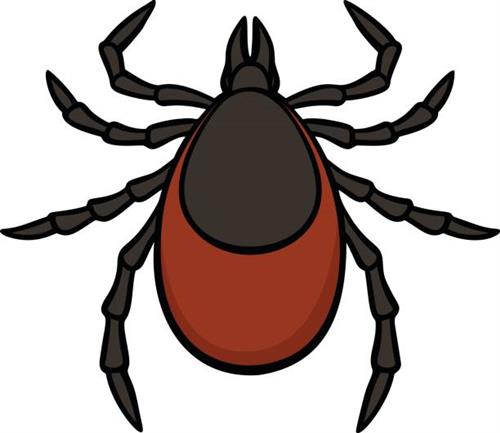- Vail Farm Elementary School
- Ticks and Lyme
-

What Are the Signs & Symptoms of Lyme Disease?
Lyme disease can affect different body systems, such as the nervous system, joints, skin, and heart.
Symptoms often happen in three stages (but not everyone has all three):
- A circular rash at the site of the tick bite often is the first sign of infection, usually within 1–2 weeks. But many people never have one.
The rash sometimes has a "bull's-eye" appearance, with a central red spot surrounded by clear skin that is ringed by an expanding red rash. It also can look like an expanding ring of solid redness. It's usually flat and painless, but sometimes can be warm to the touch, itchy, scaly, burning or prickling. The rash can look and feel very different from one person to the next, and might look like a bruise on people with darker skin. It expands over days to weeks, and eventually disappears. A person also may have flu-like symptoms such as fever, tiredness, headache, and muscle aches.
- If not treated, early symptoms may go away on their own. But in some people, the infection can spread to other parts of the body. Symptoms of this stage of Lyme disease usually start within several weeks of the tick bite, even in those who didn't have the initial rash. A person might feel very tired and unwell, or have more areas of rash that aren't at the bite site.
- The last stage of Lyme disease happens if the early stages were not found or treated. Symptoms can start anytime from weeks to years after the tick bite. In kids, this is almost always in the form of arthritis, with swelling and tenderness, particularly in the knee or other large joints.
How Do I Remove a Tick?
It's important to remove a tick as soon as possible. Follow these steps:
- Use tweezers to grasp the tick firmly at its head or mouth, next to the skin.
- Pull firmly and steadily until the tick lets go of the skin. Do not twist the tick or rock it from side to side. Parts of the tick might stay in the skin, but eventually will come out on their own.
- Wash your hands and the site of the bite with soap and water.
When Should I Call the Doctor?
Call your doctor if:
- The tick might have been on the skin for more than 24 hours.
- Part of the tick remains in the skin.
- A rash of any kind develops (especially a red-ringed bull's-eye rash or red dots on wrists and ankles).
- The bite area looks infected (increasing warmth, swelling, pain, or oozing pus).
- Symptoms like fever, headache, tiredness, stiff neck or back, or muscle or joint aches develop.
How Can I Protect My Kids From Ticks?
- After kids play outside, check their skin and hair — especially the scalp, behind the ears, around the neck, in the eyebrows and eyelashes, and under the arms.
- When playing in wooded areas, kids should wear long-sleeved shirts and pants and tuck pant legs into their socks.
- Use an insect repellent with at least 10% to 30% DEET for protection against bites and stings in kids older than 2 years. Always carefully follow the label directions for applying.

